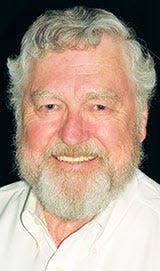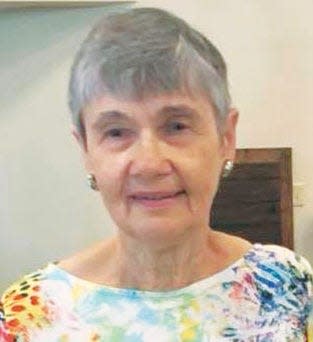Stanley Thompson: Unsung chemist with unsung impacts on Oak Ridge
- Oops!Something went wrong.Please try again later.
- Oops!Something went wrong.Please try again later.
On May 24, Carolyn Krause gave a presentation on “Unsung Scientific Heroes of 20th Century Oak Ridge History” for the Oak Ridge Heritage and Preservation Association. This two-part series on Stanley Thompson is based on part of her presentation. Frank Plasil, an Oak Ridge National Laboratory corporate fellow and physicist, as well as author of “Kaleidoscope Facets: A Memoir of Darkness and Light” (previously featured in this column), was a graduate student of Thompson’s for four years at the University of California at Berkeley.
Enjoy part one of Carolyn Krause’s series on Stanley Thompson.
***
Most Oak Ridgers have heard of Glenn Seaborg, co-discoverer of plutonium, Nobel Prize winner, chancellor at the University of California at Berkeley and chairman of the U.S. Atomic Energy Commission. Some remember the photo of him with Alvin Weinberg during the 1965 startup of the Molten Salt Reactor Experiment at Oak Ridge National Laboratory.
But have you heard of his good friend and fellow chemist par excellence, Stanley Gerald Thompson? If you “Google” Stanley Thompson, the first items that pop up are references to Stanley Thompson, the Canadian golf course architect who died in 1953. And if you look for photos and biographies of Seaborg and Stanley G. Thompson on the internet, you’ll find many more of Seaborg than Thompson.
Yet it can be argued that Thompson the chemist has had a greater impact on Oak Ridge than Seaborg. I maintain that Thompson is an unsung chemist with three largely unrecognized impacts on Oak Ridge and even Tennessee.
Those impacts sprang from his development of a non-corrosive, effective process for separating plutonium from Oak Ridge and Hanford reactor fuel to help win World War II and his discoveries of two heavy elements now produced in ORNL’s High Flux Isotope Reactor (HFIR). One element is sold for multiple uses and the other was the key to the successful international effort to synthesize Element 117, later named Tennessine after our state.

Like Seaborg, Thompson made his mark in plutonium work. He, not Seaborg, came up with the accepted process for separating plutonium from uranium slugs irradiated in a reactor – separations that made possible the atomic bombs exploded in 1945 in the New Mexico desert and over Nagasaki, Japan, ending WW II.
Seaborg and his team – McMillan, Joseph W. Kennedy, and Arthur Wahl – used a 60-inch cyclotron at UC Berkeley to make plutonium by bombarding a uranium target with deuterons (hydrogen nuclei consisting of a proton and a neutron). They isolated the man-made element on Dec. 14, 1940, and chemically identified it on Feb. 23, 1941. The next month, Seaborg, Emilio Segre, and Kennedy found that plutonium-239 bombarded with slow neutrons was capable of fission like uranium-235. That meant it could be used as nuclear fuel for an atomic bomb.

Seaborg and Thompson, both born in 1912, had been friends ever since they met as 13-year-olds in a high school in the Watts district of Los Angeles. They both majored in chemistry at UCLA and graduated in 1934. While Seaborg entered a Ph.D. program at UC Berkeley, Thompson chose to work for Standard Oil. In 1942, Seaborg moved to the Metallurgical Laboratory at the University of Chicago to develop processes for separating plutonium from irradiated uranium slugs in future reactors as part of the war effort. Seaborg hired many chemists he knew to join him in the project, including Thompson.
The lanthanum fluoride process Seaborg developed for plutonium separations was favored until it proved to be corrosive enough to eat through piping. Asked by Seaborg to investigate phosphates, Thompson developed a bismuth phosphate chemical precipitation process that retained 98% of the extracted plutonium in a precipitate (versus 50% for Seaborg’s process). Furthermore, it was not corrosive.
DuPont, which was contracted by the Army Corps of Engineers to build plutonium separation plants at Oak Ridge and Hanford, had to make a tough decision in three months. In May 1943, Charles Cooper and Crawford Greenewalt, DuPont executives, selected Thompson’s bismuth phosphate process because it was safer and more efficient. Seaborg and Thompson visited Oak Ridge monthly for a year starting in September 1943 (when the Graphite Reactor was being completed) to follow the progress in the construction and operation of the X-10 plutonium separation plant.
Thompson’s process produced the first grams of plutonium tested by Los Alamos scientists led by Segre, prompting the decision that the gun design for the uranium bomb would not work. As a result, the implosion design in which the plutonium core would be compressed by explosives was developed for the second atomic bomb.
Thompson spent 1944 and 1945 ensuring that his plutonium separations process worked at the three Hanford reactors. The plutonium was sent to Los Alamos for use in the Trinity bomb test near Alamogordo, New Mexico, and in the second atomic bomb. Possibly because of his radiation exposures at Hanford and Berkeley, Thompson died of cancer in 1976 at age 64. His process was replaced by PUREX, another Met Lab process that uses tributyl phosphate to recover plutonium from uranium rods dissolved in nitric acid.
In 1951, Seaborg and Edwin McMillan jointly won the Nobel Prize in Chemistry “for their discoveries in the chemistry of the transuranium elements” (man-made elements heavier than natural uranium). While these two eminent scientists co-discovered plutonium, Thompson described the chemical and nuclear properties of two additional transuranium elements, later named americium and curium, in his doctoral dissertation at UC Berkeley. And from 1949 through 1953, he led research teams that isolated and identified – that is, discovered – five transuranium elements: berkelium (atomic number 97), californium (98), einsteinium (99), fermium (100) and mendelevium (101).
Thompson used the ion-exchange adsorption-elution method for separating and identifying the transuranium elements while Albert Ghiorso employed improved instruments to detect each element’s unique radiation signature. Seaborg was a member of the teams.
Berkelium was named after Berkeley, but the city’s mayor was not particularly impressed. Because Thompson considered this element “a stinker” in resisting quick identification, he jokingly suggested that its symbol be “Bm.” Cooler heads prevailed, and Bk is the symbol.
Discovered in 1949 by Thompson, Ghiorso and Seaborg, Bk was made by bombarding americium-241 with alpha particles in the 60-inch cyclotron. Berkelium-249 metal (330-day half-life) can be made in weighable amounts by neutron bombardment of curium-244 in HFIR. Its only use so far has been for the synthesis of six atoms of tennessine at the Joint Institute for Nuclear Research in Dubna, Russia, in 2010.
In a deal that Vanderbilt University physicist Joe Hamilton made with Jim Roberto at ORNL, 22 milligrams of Bk-249 (97 protons) were produced at HFIR, separated, purified and sold for the experiment. The Bk target was shipped to Russia where it was bombarded with calcium nuclei (20 protons) to create Tennessine (Element 117).
Using the cyclotron, Thompson, Kenneth Street, Ghiorso and Seaborg first made californium-245 in 1950 at Berkeley by firing alpha particles at curium-242. At HFIR californium-252 is produced in milligram amounts only, by neutron bombardment of plutonium-239. A strong neutron emitter, Cf-252 is used in portable metal detectors, to identify gold and silver ores, as well as water and oil layers in oil wells, and to detect metal fatigue and strain in airplanes. It is highly effective for local control and cure of cervical cancers. Oak Ridge should be thankful for Stanley Thompson!
***
Thanks Carolyn. In the next "Historically Speaking" column Carolyn will tell us how Thompson’s contributions helped Glenn Seaborg win the Nobel Prize.
This article originally appeared on Oakridger: Stanley Thompson: Unsung chemist with unsung impacts on Oak Ridge
